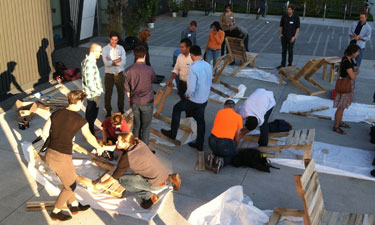 If there’s one thing human beings know how to do, it’s innovate. From the first roughly chiseled stone wheel to the Internet, humanity has shown boundless capacity to imagine and implement creative ideas to make our world safer, healthier and, simply, better. Tactical urbanism, a not-so-new idea that’s enjoying resurgence of late, is an excellent example of motivated groups and individuals taking the initiative to reimagine underused or dilapidated city spaces as spots for community congregation.
If there’s one thing human beings know how to do, it’s innovate. From the first roughly chiseled stone wheel to the Internet, humanity has shown boundless capacity to imagine and implement creative ideas to make our world safer, healthier and, simply, better. Tactical urbanism, a not-so-new idea that’s enjoying resurgence of late, is an excellent example of motivated groups and individuals taking the initiative to reimagine underused or dilapidated city spaces as spots for community congregation.
From Booksellers to Food Trucks
Documentation of perhaps the first tactical urbanists dates back to the 1500s, when les bouquinistes would set up unsanctioned stalls to sell books along the banks of the Seine River in France. These were banned in the mid-1600s then reinstated after popular outcry. In 2007, UNESCO recognized the original area occupied by les bouquinistes as a World Heritage site, and in 2012, 240 sellers boasting more than 300,000 titles, could be found selling their wares along the river. It took 500 years or so, but les bouquinistes did exactly what promoters of tactical urbanism hope their projects will do — encourage lasting, alternative uses for urban spaces.
Urban planner Mike Lydon and his team at Street Plans Collaborative literally wrote the manual on tactical urbanism. “Tactical Urbanism: Short Term Action — Long Term Change, Volume 1,” published in 2011, followed just a year later by Volume 2, details several projects taken on by galvanized community members who are willing to get creative for the betterment of their neighborhoods.
Street Plans Collective identifies five characteristics of a tactical urbanism effort:
- A deliberate, phased approach to instigating change;
- The offering of local solutions for local planning challenges;
- Short-term commitment and realistic expectations;
- Low risks, with a possibility of high reward; and
- The development of social capital between citizens and the building of organizational capacity between public-private institutions, nonprofits and their constituents.
Today’s Tactical Urbanism
Lydon became fascinated by the idea of tactical urbanism while advocating for a ciclovía-type event in Miami-Dade County, where streets are shut down weekly to allow for cyclists, runners, walkers or anyone else to meander in a safe, car-free environment. A festive community atmosphere is thus created that integrates so-called “hard infrastructure” in new ways that benefit residents — a perfect example of tactical urbanism.
Street Plans Collaborative calls out several other examples, including Open Streets, Park(ing) Day, guerilla gardening, pop-up retail, food carts/trucks, chair bombing and still others. Many have gained popularity during the past decade or so, as residents, community leaders, planners and business owners realize the potential of practically any urban area as a space for fun, fitness, commerce and unity.
“[With tactical urbanism] you get more public exposure, visibility and participation in demonstration projects,” Lydon says. “You can commit a small amount of money up front, test out ideas and see what works before you commit a huge amount of money or political capital. It’s also more intelligent in dealing with change.”
Bumps in the Road
Of course, certain tactics can technically be considered unlawful. Guerilla gardening projects involve citizens planting gardens in unexpected or underutilized spaces that are often later adopted by nearby residents, but that may not be town-sanctioned. Chair-bombing activists gather discarded materials like construction pallets and rebuild them as chairs, then place them in open areas devoid of people, or bustling corners with no comfortable seating. During Park(ing) Day demonstrations, activists turn on-street parking spaces into tiny public parks. All of these activities can be accomplished with or without the support of public officials, but to ensure their desired positive effect, there must always be community buy-in.
“Often there are event permits that are open and vague enough to get a lawful temporary street closure… but if you’re moving forward without those, most informed activists understand the risk is minor enough that they’re willing to possibly get arrested to make a point,” Lydon says. “It really is quite rare for that to happen — not to say [city officials] don’t get upset, but they tend to recognize there is often a lot of public support for these projects and that lessens the pressure to crack down…. Whether you’re doing a project from a sanctioned or unsanctioned position, think about who is around the project — the property owners, schools, others in the neighborhood. Is it a desired change? Will people support it? Is it something they’ll advocate for? It’s not hard to get a pretty good handle on the pulse of how a neighborhood feels about the possibility of making change.”
Planning for the Future
Ultimately, Lydon envisions tactical urbanism as a mechanism to bring community members into the planning process in a more active capacity. He says most folks who would be involved in urban improvement projects — city commissioners, developers, park and recreation professionals, citizens, planners and others — are all approaching those endeavors from the common vantage of improving the public space. “We’re just on the cusp of what’s possible,” says Lydon. “[Tactical urbanism] is about how can citizens take more of a leadership role with the resources at hand, design projects they want and then steward it moving forward. It’s a participatory way of making change while taking some of the burden off cities, working to build social capital at the neighborhood level…. We always need that kind of activity to push things forward.”
Learn more about tactical urbanism and the Street Plans Collaborative.
Samantha Bartram is the Associate Editor of Parks & Recreation Magazine.

